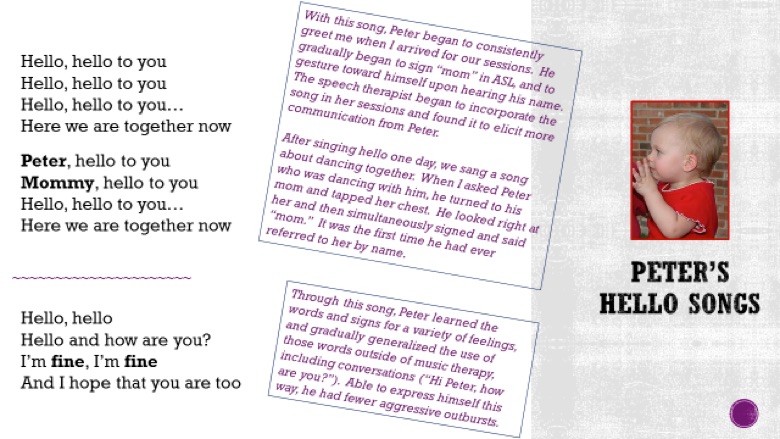Lora F. Heller, MS, MT-BC, LCAT
This podcast presents a case study of Peter, who participated in an inclusive music therapy group at his preschool that incorporated music-mediated sign language instruction. The case study highlights how he was able to generalize skills learned in music therapy to his home environment.
resources:
-
Buday, E. M. (1995). The effects of signed and spoken words taught with music on sign and speech imitation by children with autism. Journal of Music Therapy, 32(3), 189-202.
-
Humpal, M. (1991). The effects of an integrated early childhood music program on social interaction among children with handicaps and their typical peers. Journal of Music Therapy, 28(3), 161-177.
-
Humpal, M., & Tweedle, R. (2006). Learning through play – A method for reaching young children. In M. Humpal & C. Colwell (Eds.), Early Childhood and School Age Educational Settings: Using Music to Maximize Learning (pp. 153-173). Silver Spring, MD: American Music Therapy Association.
-
Kaplan, R. S., & Steele, A. L. (2005). An analysis of music therapy program goals and outcomes for clients with diagnoses on the autism spectrum. Journal of Music Therapy, 42(1), 2–19.
-
Kern, P. (2010). Evidence-based practice in early childhood music therapy: A decision-making process. Music Therapy Perspectives, 28(2), 116-123.
-
Luetke-Stahlman, B. (1994). Procedures for socially integrating preschoolers who Are hearing, deaf, and hard of hearing. Topics in Early Childhood Special Education, 14(4), 472-487.
-
Robbins, C., & Robbins, C. (1980). Music for the Hearing Impaired and Other Special Groups: A resource manual and curriculum guide. St. Louis, MO: Magna-Music Baton.
-
Schunk, H. A. (1999). The effect of singing paired with signing on receptive vocabulary skills of elementary ESL students. Journal of Music Therapy, 36(2), 110-124.
-
Schwartz, E. (2008). Music, Therapy, and Early Childhood: A Developmental Approach. Gilsum, NH: Barcelona Publishers.
-
Standley, J. M., & Hughes, J. E. (1996). Documenting developmentally appropriate objectives and benefits of a music therapy program for early intervention: A behavioral analysis. Music Therapy Perspectives, 14(2), 87-94.
-
National Fragile X Fountain. Retrieved from http://www.Fragilex.org

About the Author:
Lora is the founding director of Baby Fingers LLC, an early childhood music therapy and sign language program, and works in the music therapy program at Molloy College. She is the author of 7 sign language books for children, a chapter on music therapy in bereavement, and several parenting articles. Contact: lora@mybabyfingers.com
Suggested Citation:
Heller, L. F. (Author). (2015, September 1). Music therapy with peter: A young boy with fragile X syndrome at home and in an inclusive preschool setting. Retrieved from www.imagine.musictherapy.biz
Podcast: Play in new window | Download
Subscribe: RSS
